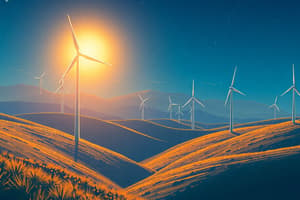Podcast
Questions and Answers
What is the primary function of the rotor in a windmill system?
What is the primary function of the rotor in a windmill system?
The primary function of the rotor is to spin when wind flows over the blades, converting wind energy into mechanical energy.
How do blade design and wind speed affect the efficiency of a windmill?
How do blade design and wind speed affect the efficiency of a windmill?
Blade design affects the lift and drag which influence how effectively the rotor spins, while higher wind speeds increase energy capture efficiency.
Explain the difference between Horizontal-Axis Wind Turbines (HAWT) and Vertical-Axis Wind Turbines (VAWT).
Explain the difference between Horizontal-Axis Wind Turbines (HAWT) and Vertical-Axis Wind Turbines (VAWT).
HAWTs have blades oriented vertically and are efficient at high wind speeds, while VAWTs rotate around a vertical axis and are suitable for turbulent winds in urban areas.
What are some applications of wind energy beyond electricity generation?
What are some applications of wind energy beyond electricity generation?
Identify one advantage and one challenge associated with wind energy as a renewable source.
Identify one advantage and one challenge associated with wind energy as a renewable source.
Discuss the significance of technological advancements in the future of wind energy.
Discuss the significance of technological advancements in the future of wind energy.
How does location impact the effectiveness of wind energy generation?
How does location impact the effectiveness of wind energy generation?
What role does the generator play in the windmill principle, and how does it function?
What role does the generator play in the windmill principle, and how does it function?
Flashcards are hidden until you start studying
Study Notes
Windmill Principle in Engineering
-
Definition: The windmill principle refers to the mechanics of converting wind energy into mechanical energy through the use of wind turbines or windmills.
-
Basic Components:
- Blades: Capture wind energy, designed to maximize lift and minimize drag.
- Rotor: The part of the windmill that includes the blades; spins when wind flows over the blades.
- Generator: Converts mechanical energy from the rotor into electrical energy.
- Tower: Supports the rotor and generator at a height to capture stronger winds.
-
Working Principle:
- Wind Flow: Wind impacts the blades, creating lift and causing the rotor to spin.
- Mechanical Energy Conversion: The rotational motion of the rotor drives a shaft connected to a generator.
- Electricity Generation: The generator transforms the kinetic energy into electrical energy, which can be used or stored.
-
Types of Windmills:
- Horizontal-Axis Wind Turbines (HAWT): Most common; blades oriented vertically; efficient at high wind speeds.
- Vertical-Axis Wind Turbines (VAWT): Blades rotate around a vertical axis; suitable for turbulent winds and urban settings.
-
Applications:
- Electricity Generation: Wind farms for renewable energy production.
- Pumping Water: Used in agriculture and rural areas for irrigation.
- Mechanical Tasks: Historical uses for milling grain and sawing wood.
-
Efficiency Factors:
- Wind Speed: Higher speeds increase energy capture efficiency.
- Blade Design: Shape and material influence performance.
- Location: Placement in areas with consistent wind patterns enhances effectiveness.
-
Environmental Impact:
- Advantages: Clean energy source; reduces greenhouse gas emissions; renewable.
- Challenges: Noise, visual impact, and risk to wildlife (e.g., birds and bats).
-
Future Trends:
- Technological Advancements: Improvements in design and materials for better efficiency.
- Offshore Wind Farms: Development of wind turbines in marine environments for higher output.
- Hybrid Systems: Combining wind energy with other renewable sources for more stable energy supply.
Windmill Principle
- The windmill principle describes how wind energy is transformed into mechanical energy using wind turbines or windmills.
- Key components of a windmill include blades, a rotor, a generator, and a tower.
- Blades are designed to maximize lift and minimize drag, capturing wind energy.
- The rotor includes the blades and rotates when wind flows over them.
- The generator converts mechanical energy from the rotor into electrical energy.
- The tower supports the rotor and generator at a height to access stronger winds.
Windmill Operation
- Wind flows over the blades, creating lift and causing the rotor to spin.
- The rotor's rotation drives a shaft connected to the generator.
- The generator transforms kinetic energy into electrical energy.
Types of Windmills
- Horizontal-Axis Wind Turbines (HAWT)
- Most common type
- Blades are oriented vertically
- Efficient at high wind speeds
- Vertical-Axis Wind Turbines (VAWT)
- Blades rotate around a vertical axis
- Suitable for turbulent winds and urban settings
Windmill Applications
- Generating electricity in wind farms for renewable energy production.
- Pumping water for agriculture and rural irrigation.
- Performing mechanical tasks like milling grain and sawing wood (historical uses).
Efficiency Factors
- Wind Speed: Higher wind speeds increase energy capture efficiency.
- Blade Design: Shape and material influence performance.
- Location: Placement in areas with consistent wind patterns enhances effectiveness.
Environmental Impact
- Advantages: Clean energy source, reduces greenhouse gas emissions, renewable.
- Challenges: Noise, visual impact, and risk to wildlife (birds and bats).
Future Trends
- Technological Advancements: Improvements in design and materials for better efficiency.
- Offshore Wind Farms: Development of wind turbines in marine environments for higher output.
- Hybrid Systems: Combining wind energy with other renewable sources for a more stable energy supply.
Studying That Suits You
Use AI to generate personalized quizzes and flashcards to suit your learning preferences.




